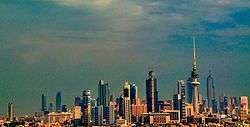National Assembly (Kuwait)
| National Assembly of Kuwait | |
|---|---|
| 14th Legislative Session | |
|
Coat of Arms of the State of Kuwait | |
| Type | |
| Type | |
Term limits | None |
| History | |
New session started | August 6, 2013 |
| Leadership | |
|
vacant | |
|
vacant | |
Secretary |
vacant |
Controller |
vacant |
| Structure | |
| Seats |
50 elected members Up to 15 appointed members |
Length of term | Four years |
| Elections | |
| Single non-transferable vote | |
Last election | July 27, 2013 |
Next election | November 26, 2016[1] |
| Meeting place | |
 | |
|
Building of the National Assembly of Kuwait Kuwait City, Kuwait | |
| Website | |
|
kna | |
 |
| This article is part of a series on the politics and government of Kuwait |
|
Constitution |
|
Recent elections
|
|
Related topics |
The National Assembly (Arabic: مجلس الأمة), is the unicameral legislature of Kuwait. The National Assembly meets in Kuwait City. Members are chosen through direct election; the country is divided into five electoral districts with ten members representing each district. There are no official political parties in Kuwait, therefore candidates run as independents during elections; upon winning, members usually form informal parliamentary blocs. The National Assembly is made up of 50 elected members as well as up to 15 appointed government ministers who are ex officio members. On October 16, 2016, the Amir of Kuwait issued a decree dissolving the National Assembly citing security challenges,[2] paving the way for early elections within sixty days. The date of the next election has been set for November 26, 2016.
Overview
The National Assembly is the legislature in Kuwait.[3] The National Assembly has the power to remove government ministers from their post. MPs frequently exercise their constitutional right to interpellate government members. The National Assembly's interpellation sessions of ministers are aired on Kuwaiti TV. MPs also have the right to interpellate the prime minister, and then table a motion of non-cooperation with the government, in which case the cabinet must get replaced.
The National Assembly can have up to 50 MPs. Fifty deputies are elected by popular vote to serve four-year terms. Members of the cabinet also sit in the parliament as deputies. The constitution limits the size of the cabinet to 16, and at least one member of the cabinet must be an elected MP. The cabinet ministers have the same rights as the elected MPs, with the following two exceptions: they do not participate in the work of committees, and they cannot vote when an interpolation leads to a no-confidence vote against one of the cabinet members.
The National Assembly is the main legislative power in Kuwait. The Emir can veto laws but the National Assembly can override his veto by a two-third vote. The National Assembly (per article 4 of the Constitution) has the constitutional right to approve and disapprove of an Emir's appointment. The National Assembly effectively removed Saad al-Sabah from his post in 2006 because of Saad's inability to rule due to illness. Kuwait's National Assembly is the most independent parliament in the Arab world;[4] it is among the strongest parliaments in the Middle East.[5]
Dissolutions
The Constitutional Court has the authority to dissolve the house and must subsequently call for new elections within two months. The Constitutional Court is widely believed to be one of the most judicially independent courts in the Arab world.[6] The Emir also has the authority to dissolve the house and must subsequently call for new elections within two months. The Constitutional Court can invalidate the Emir's decree dissolving the parliament.
Building
The parliament building was designed by Danish architect Jørn Utzon, who also designed Sydney Opera House.
Political factions
While political parties are not legally recognized in Kuwait, a number of political factions exist. The house is composed of different political factions in addition to independents:
- The liberal, secular bloc: Ten members were elected in the 2013 elections, making them the largest political bloc in the current parliament.
- The Shaabi (populist) bloc: A coalition of populists (Sunni and Shia), liberals and nationalist parties with a focus on middle-class issues. The Popular Action Bloc is their main political party.
- The Islamist bloc: Consisting of Sunni Islamist members. The Islamist bloc has 3 members elected in the 2013 national elections.
See also
- Politics of Kuwait
- Government of Kuwait
- Elections in Kuwait
- List of Speakers of Kuwait National Assembly
- Kuwait National Assembly No-Confidence Votes
References
- ↑ Allen Cone (October 17, 2016). "Kuwait sets Nov. 26 as date for parliamentary elections". UPI. Retrieved October 17, 2016.
- ↑ Hussain Al-Qatari & Jon Gambrell (October 16, 2016). "Kuwaiti cabinet resigns, parliament dissolves". Associated Press News. Retrieved October 16, 2016.
- ↑ Robert F. Worth (2008). "In Democracy Kuwait Trusts, but Not Much". New York Times.
- ↑ Nathan J. Brown. "Mechanisms of accountability in Arab governance: The present and future of judiciaries and parliaments in the Arab world" (PDF). pp. 16–18.
- ↑ Eran Segal. "Kuwait Parliamentary Elections: Women Making History" (PDF). Tel Aviv Notes. p. 1.
- ↑ "Kuwait court ruling may threaten economic recovery". Reuters. 15 May 2013. Retrieved 1 July 2013.
